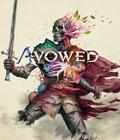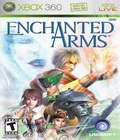Genre: RPG
Publisher: Ubisoft
Developer: From Software
Release Date: August 29, 2006
While first-person shooters and sports games were a dime a dozen on the Xbox, RPGs were incredibly few and far between. Microsoft's system housed a few excellent examples of the genre, such as Star Wars: Knights of the Old Republic, but they were the rare exception, and the few offerings did little to satisfy the hunger of RPG fans. This turned a lot of die-hard RPG fans away from the Xbox and over toward Sony's PlayStation 2. Microsoft has taken these complaints to heart for their next-generation console, and the Xbox 360's RPG lineup is growing by the day with support from companies both new and old. While the big-name RPG titles such as Lost Odyssey and Blue Dragon are still a ways off, Enchanted Arms is an excellent appetizer for fans hungry for next-gen RPGs.
Enchanted Arms is the story of Atsuma, a trainee Enchanter studying at Yokohama University, one of the premier schools for Enchanters in the world. Enchanters are known for their ability to create Golems, artificial beings capable of everything from household chores to warfare, as well as other feats of magical prowess. Although Atsuma is dull-witted, lazy and constantly late, he manages to scrape by with help from his friends Toya, the top student, and Makoto, their flamboyantly gay compatriot. Atsuma's problems with Enchanting are only made more difficult by his right arm, which has the unique ability to nullify any Enchantment with which it comes in contact. When Atsuma's arm accidentally releases a legendary Devil Golem housed under Yokohama, it's up to him to figure out how to defeat it before it destroys the entire world.
Enchanted Arms' storyline is definitely its weakest component. Anyone who's at all familiar with RPGs will be able to predict every second of the plot and will always be correct. Every minute of the plot is so generic that you'll want to rush through plot segments to get to the next dungeon. For the most part, the characters are all the generic Japanese RPG clichés that have appeared in every game. The spunky rebellious princess, the childish female thief, and the broodingly silent swordsman all make their requisite appearances. The only real character to stand out is Makoto, who amusingly fights with a saxophone and fulfills the role usually held by the childhood female friend in the early segments of the story. The rest of the characters, both NPCs and party members, tend to be forgettable, and only really serve to remind the player of better versions of the same archetype.
While the plot characters are not the most interesting of people to journey with, they're not the only people to fight alongside you. As an Enchanter, Atsuma can recruit hundreds of different Golems to fight alongside him. Some can be purchased from stores, but by and large, most of the Golems must be defeated in combat before they'll join you. From the humanoid gun-wielding maid Primrose to the legendary phoenix Phoenica, each Golem has a different look, element and set of abilities. Some specialize in support magic, while others are pure physical power. Each Golem also has its own unique biography, which adds a little bit of extra character to each creature. Choosing a balanced team of Golems can mean the difference between victory and defeat in some of the game's tougher battles. The one downside to Golems is that, unlike humans, they can't learn new abilities; what they know at the outset is what they're stuck with for the entire game. While you may feel bad leaving behind your first Golem once it gets outdated, it's a necessity to keep up with the increasingly strong enemies.
In contrast to the lackluster plot, Enchanted Arms's battle system is where the game really begins to shine. Enchanted Arms uses an 8x4 grid-based system, with the battle screen divided into two 4x4 segments, one for the player and one for the enemy. While players and enemies can move within their own segment, they can't move into enemy territory, so choosing attacks is very important. Is it better to use attacks that hit more enemies but are weaker, strong attacks that can only hit the front row, or long-distance attacks that require more difficult positioning? Each attack also has an Enchant Point cost, which is roughly similar to Magic Points in other RPGs. Weaker attacks cost fewer EP, while stronger or wider-range attacks cost more. EP can be regenerated by using the "stand by" command and sacrificing a turn, but that's another turn in which the enemy can attack your party.
On top of that, each character and some attacks have an elemental attribute. Fire opposes Water, Earth opposes Wind, and Light opposes Dark. When using an elemental attack on the enemy of the same attribute, the damage is halved, but when using that same attack on an enemy of the opposing attribute, the damage is doubled, which adds an extra dimension to party planning. If you're trekking through a volcano, a water-based team could destroy enemies in a turn, but the same can go both ways.
One of the more interesting systems that Enchanted Arms brings to the table is Vitality Points. At the end of every battle, a character's Hit Points and Enchant Points are restored to max, but they lose a number of Vitality Points in exchange. A few-turn battle with little damage will usually only lead to the loss of one or two VP, while a knock-down, drag-out boss fight could leave your party reeling. The big exception is single-turn victories. If the player can defeat the enemies in a single turn, there is no loss of VP for that battle, which encourages players to plan out their turns carefully. While Atsuma has 100 VP, that amount varies among the other characters. Extremely strong Golems tend to have 15 or less, which makes using them a risk unless you use careful planning in battle. Characters not in your active party slowly regenerate VP as long as their VP isn't at zero, which prompts the player to switch around the active party frequently.
Players should be warned: Enchanted Arms has an extremely high encounter rate. Although the battle system is fun, it can be very frustrating to get in seven fights just trying to solve a simple crate puzzle. To make matters worse, Enchanted Arms requires a lot of backtracking through areas you've already traversed, and whose enemies are far too weak for your party. To those who want to go search for missed Golems later in the game, the Evade Encounter ability almost becomes mandatory to prevent exploration from becoming tedious. Thankfully, the game's Auto Battle feature is competent enough for these simple battles, and Enchanted Arms features a very welcome feature that lets you speed up animations that you've already seen, making pointless battles go by much quicker.
Most combat is just challenging enough to require tactics, while easy enough to avoid being frustrating. If your party is wiped out due to an unfortunate mistake, you can simply restart the battle and try again. As a result, Enchanted Arms falls just a bit too much on the easy side. Die-hard RPG fans will probably plow through the game fairly quickly, but casual players will welcome a game that's challenging without being frustrating. While most of the early boss battles are a bit too simple, the later battles provide just enough challenge to keep things fresh.
The dungeons themselves are few and simple. Usually they are just a series of corridors, straightforward and quite linear, with the occasional side-path leading to treasure. A few puzzles exist to spice things up, but they are all incredibly simple and shouldn't take more then a moment's thought to solve. Exploration is spiced up a bit by Atsuma's ether grappling hook, which allows him to swing across gaps, but since this can only be done at predetermined locations, it comes off as more of a gimmick than an actual exploration tool.
Graphically, Enchanted Arms looks beautiful. The places Atsuma and his friends visit are vibrant and beautiful, ranging from the damp streets of London to the cherry blossom-covered city of Kyoto. Each has its own distinctive design, and you'll never mistake one area for another. A few of the dungeons seem a bit empty, especially later on in the game. (The last dungeon is only three screens long and rather dull, considering all the buildup.) However, despite the huge beautiful environments, they are mostly for show, and there is very little interaction with the beautiful cities. The characters and Golems all look spectacular and are extremely well animated, definitely looking next-gen. There are a few minor graphics glitches like floating shadows, but they're not enough to distract from the total appearance at all. The few action cut scenes in the game are jaw-dropping, and really showcase what the Xbox 360 can do, but most of the cut scenes are shots of the character models against a darkened background. They don't look bad by any stretch of the word, but in comparison to the action-oriented cut scenes, they're rather lacking. Overall, Enchanted Arms really is a graphically amazing RPG.
While it's visually remarkable, Enchanted Arms's audio is not quite up to scratch. The English voice work in particular is seriously lacking. Golem Hunter Yuki's voice alone can give the player a massive headache during extended vocal scenes. Thankfully, Ubisoft included the option to switch the game to Japanese voiceovers. Though not quite the best the genre has ever heard, the Japanese voices are leaps and bounds better than the English ones, and once you switch over, you'll never switch back. On top of everything else, only some voices were dubbed in English, and a good portion of Golems speak in Japanese no matter what setting you're on. It's a minor problem but can be rather weird and is just another point against the game's English voice acting. The background music is fairly well done, but not particularly memorable. It never gets annoying or repetitive, but you won't be humming it after the game is off, either.
Clocking in at roughly 30 hours of gameplay, Enchanted Arms isn't one of the longer RPGs on the market. However, after the storyline is finished, there are still a lot of things to do. Die-hard collectors will enjoy gathering all of the different Golems, and there is a bonus dungeon which houses a few exclusive Golems and a surprisingly tough hidden boss. The really big draw for Xbox Live fans is Enchanted Arms's online battle mode, where players can pit their Golems against players across the globe. Even though poor balance means that players will end up seeing the same few Golems over and over, there's enough variation to keep things interesting for fans of online battling.
Enchanted Arms is an excellent first foray into the next generation of RPGs for Microsoft. It's both beautiful to see and a lot of fun to play. While its low difficulty and generic story means that it's destined to be forgotten once Blue Dragon or Trusty Bell gets released, it's more than enough to show fans that Sony isn't the only RPG game in town anymore.
Score: 7.5/10
More articles about Enchanted Arms












 Embark on an epic RPG adventure and escape to a fantasy world filled with beautiful cinematic-quality graphics, unique characters and bizarre creatures. Take on the role of Atsuma, Enchanter in-Training and transform from a naïve student into the most powerful savior in a war 1,000 years in the making. Immerse yourself in a deep storyline as you face increasingly difficult challenges and learn to master Atsumas special fighting and magical abilities.
Embark on an epic RPG adventure and escape to a fantasy world filled with beautiful cinematic-quality graphics, unique characters and bizarre creatures. Take on the role of Atsuma, Enchanter in-Training and transform from a naïve student into the most powerful savior in a war 1,000 years in the making. Immerse yourself in a deep storyline as you face increasingly difficult challenges and learn to master Atsumas special fighting and magical abilities.






















